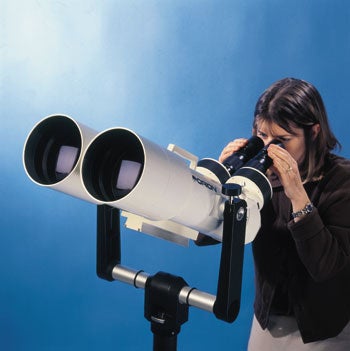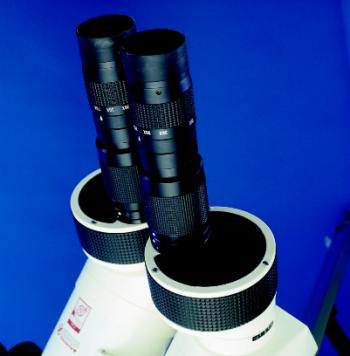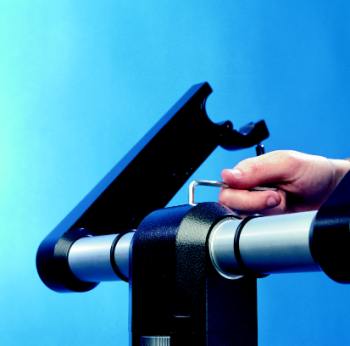Recently, Orion Telescope Center of Santa Cruz, California, introduced three mammoth binoculars into the United States. The trio is manufactured by Vixen Optical Industries of Tokorozawa, Japan — a company long known for excellent telescopes and eyepieces. This report examines the newest member of that group, an impressive pair of 25x to 75x zoom binoculars. No ordinary giant binoculars, these heavyweights are, in effect, a pair of 4.9-inch f/5 achromatic refractors mounted in tandem and outfitted with a pair of Vixen Lanthanum 8mm to 25mm zoom eyepieces, a formidable combination for probing the night sky. The eyepieces are continuously variable but have preset detents at 25, 38, 50, and 75 power.
The entire outfit (binoculars, tripod, and alt-azimuth mount) is shipped directly from the factory. The binoculars are painted a glossy, baked-enamel white, and the fork mount is painted black. I was immediately impressed by the setup’s light weight. The aluminum tripod and mounting are quite light for such heavy binoculars. The glasses themselves tilt the scales at 24 pounds, but the complete package only weighs 38 pounds.
Assembling the binoculars is a five-minute operation. The fork-style alt-azimuth mount easily connects to the tripod and is secured by a large, captive bolt. Although they may be on the heavy side for some people, a large handle set between the barrels makes transporting them easier.
Once placed in the fork mount, two hinged clamps hold the binoculars in place — one on each arm. The clamps also serve as an altitude brake to keep the binoculars from moving accidentally during use. This simple, effective arrangement reflects Vixen’s thoughtful design. It would have been less expensive to use a nut and bolt method of attaching the binoculars, but that would require the use of hand tools and loose hardware. Ever fumble around at night for a bolt that accidentally fell into high grass? It’s not a pleasant way to begin an observing session.
The fork arms may be tilted or positioned vertically. Tilting the mount offsets the binoculars from the center of the tripod. This makes it much easier to look through the eyepieces when the glasses themselves are tilted at angles greater than 45°. Although this shifts the center of gravity away from the center of the tripod, it does not affect the mount’s stability.
Tilting the arms is the only part of setup that requires a separate tool, a small Allen wrench, which is supplied. In practice, I left the arms tilted at 45°, so readjustment was unnecessary, but had I wanted to adjust them again in the field, I would have had to remember to bring the wrench with me. It would be nice if Vixen had added a small retention mount on the inside of one of the fork arms for the Allen wrench, but this is a small point of contention.
At first, I expected the fork mounting to be too lightweight to support the binoculars, but a quick test showed that it was up to the task. With the tripod legs fully extended and the binoculars zoomed to 75x, I rapped the side of the instrument barrel sharply with the ball of my hand. My own subjective rule is that if an instrument stops vibrating after no more than three seconds, stability is “excellent,” from 4 to 6 seconds, stability is “good”; 7 to 10 seconds rates “acceptable”; while greater than 10 seconds is “unacceptable.” The Vixen binoculars averaged between 4 and 5 seconds.
Despite some creaking when the binoculars were moved to the left or right, the alt-azimuth mount moved very smoothly. Panning back and forth, up and down was a pleasure, especially along the Milky Way. Despite their size, these binoculars still conveyed that sense of freedom not often experienced through a telescope.
As with all binoculars, it is important to adjust them to the individual observer. The Vixen’s interocular distance (the spacing between the two eyepieces) is adjusted to match the observer by pivoting the round prism assemblies until the two fields of view merge. As with all monster binoculars, focusing is done individually by turning the barrel of each eyepiece. Although this routine may seem inconvenient to some, focusing is smooth and simple to achieve. Twisting the second ring on each barrel also individually sets the magnification for each eyepiece.
Once everything was set, I began my tour of the universe. Even before aiming at a particular target, I was immediately impressed by how sharp star images were across the entire field of view, regardless of magnification. Coma and curvature of the field, two common binocular aberrations, especially in zoom models, were absent. Eyeglass wearers will also appreciate the 20mm eye relief. Even those who wear glasses because of astigmatism should have little trouble seeing the full field of view.
To work properly, binocular barrels must be perfectly aligned parallel to one another. If the barrels are misaligned, even by a small amount, the images can cause eye fatigue and headaches. The problem is tough enough to avoid in smaller models, but it is especially important at these high magnifications. Because of their girth, I feared the Vixen binoculars might flex and shift when moved from horizon to zenith. But after repeated use, they remained perfectly aligned and unvarying, regardless of angle or viewing position.
I enjoyed some spectacular deep-sky sights through these binoculars. Wide-field views of the Orion Nebula (M42), the Pleiades (M45), Double Cluster (NGC 869 and NGC 884), and Andromeda Galaxy (M31) were especially memorable. One of the most impressive sights for me was that of the Andromeda Galaxy at 25x. To one side stood the small companion galaxy M32, to the other the ghostly glow of a second companion (NGC 205), while the silhouette of one of M31’s dark rifts girded the galactic disk. Other sights, such as resolving stars in globular clusters M13 and M22, looking at the billowing nebulous patches of the Lagoon Nebula (M8), or spotting the dim glow of the Veil Nebula (NGC 6960 and NGC 6992-5) also proved that two eyes are indeed better than one.
As much as I enjoyed the views, all is not perfect with these binoculars. Earlier, I noted that each eyepiece’s focusing mechanism was smooth and simple. That’s a good thing, since the eyepieces are not parfocal across their zoom range. In other words, they had to be refocused whenever the eyepieces were zoomed in or out, a real inconvenience. I also caught myself confusing the focusing rings on the eyepieces with those that vary the zoom. Granted, it’s just a matter of becoming familiar with what each ring does, but the constant need to refocus was disappointing.
Although coma and curvature of field were nowhere to be found, false color or secondary spectrum plagued the view of bright objects. Celestial sights such as Jupiter and its moons, the moon, and Saturn’s beautiful rings were all sharp. Unfortunately, they were also marred by unnatural, purplish edges. These binoculars use fast, f/5 achromatic objectives. They cannot and do not eliminate secondary spectrum as completely as instruments with apochromatic objectives or slower focal ratios. So, while the false color was not surprising, I found the purplish rim annoying.
I was also disappointed that the zoom eyepieces were not removable. Vixen zoom eyepieces are among the finest sold today, but I would have preferred the ability to substitute my own premium eyepieces in their place. Not only would removable eyepieces greatly expand the magnification range, they would also let observers mate the binoculars with a pair of nebula filters. Together, that would have been a dynamite setup for viewing large emission nebulae. It’s unfortunate that option isn’t available.
Although the binoculars do not come with a finderscope, a dovetail base is supplied that will accept a number of Vixen-manufactured finders — a must-have accessory in my opinion. An optional 7×50 finder is available through Orion for $200. Although, for the cost of these binoculars, I am disappointed that Vixen doesn’t supply a standard, small 6x finder. Should you prefer to leave the driving to someone else, the fork mount may also be outfitted with custom-fit digital setting circles.
Another must with these binoculars is an adjustable observing chair. The eyepieces, tilted at 45°, can be difficult to get to when the binoculars are looking at an object much above 60° in altitude. A chair will make viewing such objects more comfortable. As with refracting telescopes, 45° prisms are better suited for terrestrial viewing. A 90&mdeg;-prism setup would be more conducive to astronomical observing.
A double-eyed view of the universe comes at a price. For the same investment, an observer can purchase a 5-inch apochromatic refractor (without a mount), a 10-inch computer-guided Schmidt-Cassegrain telescope, or a premium 18-inch Newtonian reflector and still have money left for a few eyepieces or accessories. Of course, as good as those instruments are, they only show a single-eyed view of the universe.
Binocular enthusiasts may also select among other gargantuan binoculars by Nikon, Fujinon, and Miyauchi. Miyauchi’s line of 100mm binoculars is especially note-worthy, since they offer both semi-apochromatic and apochromatic models, which have superior false-color, as well as interchangeable eyepieces. None of these other binoculars, however, comes with its own mounting, yet all still carry exorbitant price tags ranging from $2,300 to more than $13,000. When you take that into consideration, the Vixen 25-75×125 binoculars are hard to beat in both price and performance.












